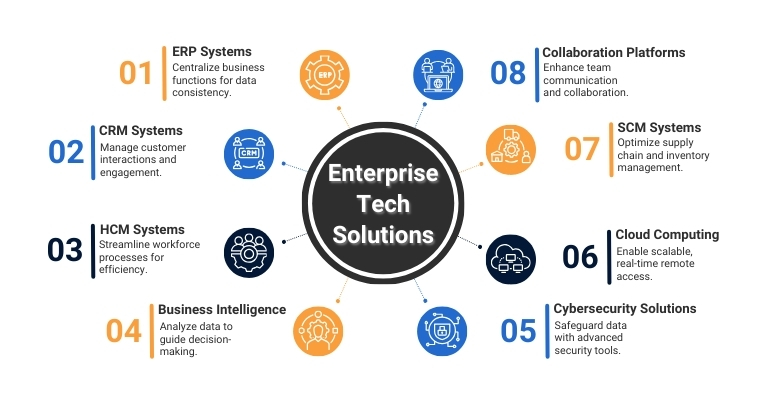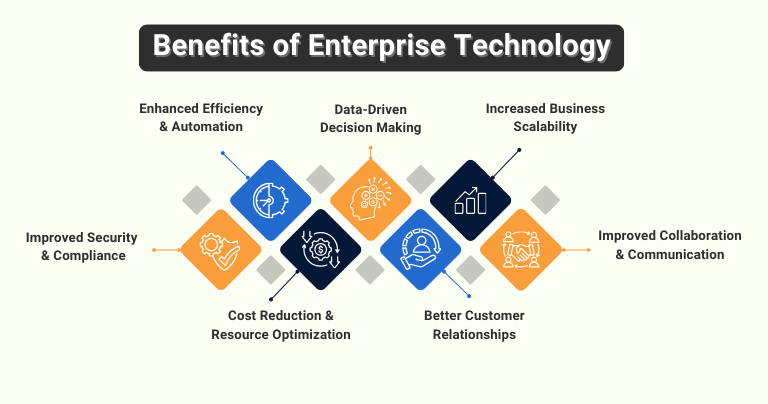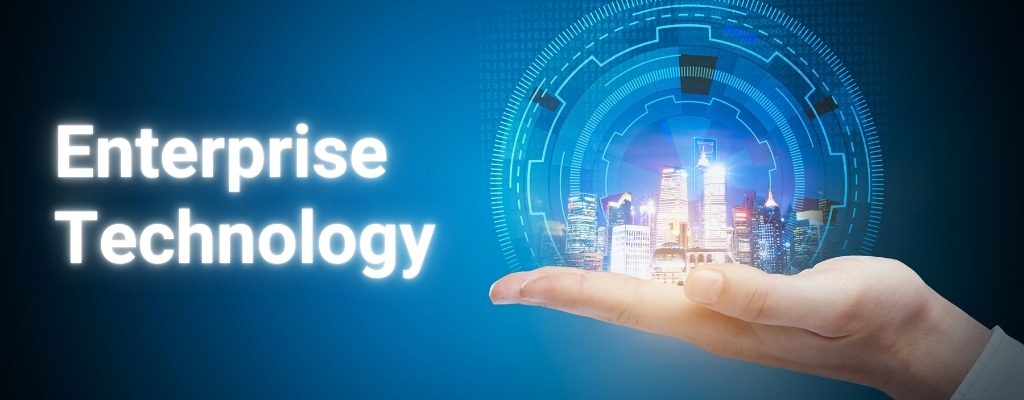Enterprise technology integrates advanced software, hardware & IT processes, enabling businesses to achieve digital transformation.
ERP systems, CRM platforms & BI tools boost operational visibility by centralizing various business functions. For example, ERP systems consolidate finance, HR & supply chain processes, improving visibility, control & efficiency.
These technologies help automate repetitive tasks, reduce errors, and enable a focus on strategic initiatives.
Types and Solutions of Enterprise Technology
Enterprise technology comprises specialized systems and software solutions designed to meet the complex needs of large organizations. Below are the key types of enterprise technology and the software solutions that drive operational efficiency:

1. ERP Systems (Enterprise Resource Planning):
- Overview: ERP systems centralize key business functions, including finance, human resources, procurement, and supply chain.
- Software Solution: ERP software integrates these functions into a single platform, enhancing data consistency and providing real-time visibility, enabling precise decision-making. ERP for small businesses can also be customized to meet their growing needs.
2. CRM Systems (Customer Relationship Management):
- Overview: CRM systems focus on customer engagement, helping businesses track leads and manage customer interactions.
- Software Solution: CRM software centralizes customer data, enabling businesses to improve relationships and provide personalized services that are especially beneficial for professional service providers.
3. HCM Systems (Human Capital Management):
- Overview: HCM systems manage workforce processes, including recruitment, onboarding, and employee development.
- Software Solution: HCM software supports payroll, performance tracking, and workforce planning, enhancing productivity and resource efficiency.
4. Business Intelligence (BI) Tools:
- Overview: BI systems analyze data to provide insights for decision-making.
- Software Solution: BI tools aggregate data across departments, allowing organizations to identify inefficiencies, explore opportunities & make proactive changes. These tools are essential for business process improvement and maintaining a competitive edge through data-driven decisions.
5. Cybersecurity Solutions:
- Overview: As enterprises handle sensitive data, cybersecurity is significant for safeguarding against breaches and ensuring regulatory compliance.
- Software Solution: Cybersecurity tools such as firewalls, encryption, and AI-driven threat detection help protect data and maintain system integrity.
6. Cloud Computing and Integration:
- Overview: Cloud technologies enable scalable and flexible access to data, while enterprise technology integration solutions ensure seamless data flow across enterprise systems.
- Software Solution: Cloud platforms support remote access and integration, promoting real-time collaboration across departments essential for modern enterprises.
7. SCM Systems (Supply Chain Management):
- Overview: SCM systems improve logistics, inventory management, and supplier coordination, creating an agile supply chain.
- Software Solution: SCM software manages inventory, logistics, and supplier relationships, ensuring on-time product delivery is vital for manufacturing and distribution companies.
8. Collaboration and Communication Platforms:
- Overview: Effective communication is key to enterprise success, enabling cross-team collaboration.
- Software Solution: Platforms like Microsoft Teams, Slack & Google Workspace keep teams connected, support virtual meetings and foster collaboration.
By integrating these technology types and leveraging specific software solutions, enterprises can achieve greater efficiency, scalability, and agility while maintaining competitiveness in an increasingly complex market landscape.
Key Trends in Enterprise Technology
| Trend | Description | Companies Using This Trend |
|---|---|---|
| AI and Machine Learning | To maintain a competitive edge, AI and ML transform data processing, automate workflows, and enable predictive analytics for better decision-making. LLMs in ERP deliver actionable insights efficiently. | Google, IBM, Microsoft |
| Cloud Computing | To meet growing business needs, cloud computing enables scalability, remote access, and cost efficiency. Hybrid and multi-cloud options provide customized, seamless solutions for business needs. | Amazon (AWS), Microsoft (Azure), Google (Google Cloud) |
| Edge Computing | To support real-time operations, edge computing processes data near its source to reduce latency and improve efficiency. Ideal for industries needing real-time insights, such as healthcare and manufacturing. | Cisco, Hewlett Packard Enterprise (HPE), Dell Technologies |
| Cybersecurity | With increased data accessibility, advanced AI-driven threat detection and multi-layered protection are essential for securing data against evolving threats. | Palo Alto Networks, CrowdStrike, Fortinet |
| Business Process Automation | To improve productivity, business process automation (BPA) streamlines workflows and reduces manual effort, allowing professionals to focus on strategic, client-facing activities. | UiPath, Automation Anywhere, Blue Prism |
| Data-Driven Decisions | To remain competitive, enterprises use BI tools to analyze data, identify trends, and enable proactive, strategic decision-making. | Tableau (Salesforce), SAS, IBM |
Haile Solutions helps businesses utilize these trends to improve operational efficiency and drive growth. We specialize in enterprise technology consulting and assisting companies with AI implementation, cloud integration, etc. With expertise in ERP for professional services, process improvement, ERP selection, and project management, Haile Solutions ensures that professional service businesses stay ahead of technological advancements with effective and customized solutions.
Benefits of Enterprise Technology

Implementing enterprise technology brings numerous advantages that transform business operations, drive efficiency, improve decision-making, and increase productivity. Below are the key benefits of enterprise technology:
1. Enhanced Efficiency and Automation:
Tools like ERP systems and BPA automate repetitive tasks, reducing manual intervention and freeing employees to focus on higher-value activities. This minimizes errors and accelerates workflows, significantly boosting operational efficiency.
2. Data-Driven Decision Making:
Enterprise technology provides real-time data and actionable insights for informed decision-making. BI tools analyze cross-functional data to identify trends and inefficiencies, facilitating proactive business process improvement.
3. Scalability:
Enterprise technology is built to grow with the business. Systems like ERP can be customized and scaled to meet evolving needs, supporting growth without significant operational disruptions.
4. Improved Collaboration and Communication:
Integrating enterprise technology strengthens collaboration by linking systems and enabling smooth data flow. Platforms like Slack and Microsoft Teams foster effective communication and project coordination, which is especially important for professional service firms.
5. Better Customer Relationships:
CRM systems help businesses manage customer interactions effectively, enabling personalized services that elevate satisfaction and loyalty. Centralized customer data helps companies better understand client needs and tailor their services accordingly.
6. Cost Reduction and Resource Optimization:
Enterprise technology integrates core business functions into a single platform, identifying inefficiencies and optimizing resource utilization. The result is cost savings that can be redirected towards growth and innovation.
7. Improved Security and Compliance:
Cybersecurity tools safeguard sensitive business data and ensure compliance with regulations. Features like multi-layered security and AI-driven threat detection reduce data breach risks and ensure data integrity.
Enterprise technology helps businesses optimize operations, improve customer interaction, and adapt more efficiently to market changes. Professional service providers benefit greatly from these solutions by enhancing project management, strengthening client relationships, and boosting workforce productivity.
Challenges in Adopting Enterprise Technology
Despite the numerous advantages of enterprise technology, its adoption presents several challenges that businesses must overcome for successful transformation. Below are the key challenges and practical solutions for overcoming them:
1. Integration Complexity:
- Challenge: Integrating new technologies with legacy systems that have been in place for years can be complicated.
- Solution:
- Conduct a System Audit: Assess existing systems for compatibility issues and integration requirements.
- Use Middleware Solutions: Middleware bridges new and old systems, ensuring smooth data flow.
- Partner with an Integration Specialist: Specialists help identify the best integration strategies, reducing disruptions.
2. High Implementation Costs:
- Challenge: Implementing enterprise technology solutions, such as ERP or CRM systems, can be costly, particularly for small to medium-sized businesses.
- Solution:
- Phased Implementation: Spread costs by adopting a phased approach, making it easier to manage budgets.
- Opt for Cloud-Based Solutions: Cloud ERP and CRM systems use a subscription model, reducing upfront costs.
- Conduct ROI Analysis: Justify costs with a detailed return on investment analysis and identify cost-saving areas.
Read More: Detailed guide to ERP implementation cost.
3. Change Management:
- Challenge: New technologies often require changes in workflows, making it challenging for employees to adapt.
- Solution:
- Employee Training Programs: Invest in training to educate employees on system benefits and usage.
- Appoint Change Champions: Assign “change champions” to guide teams during the transition.
- Ensure Clear Communication: Regularly communicate the reasons for change, its benefits, and the positive impacts on individual roles.
4. Data Migration and Quality Issues:
- Challenge: Migrating data from legacy systems can lead to data quality issues.
- Solution:
- Perform Data Cleansing Before Migration: Clean data to eliminate inaccuracies or incomplete information.
- Use Data Migration Tools: Utilize specialized tools to automate and validate the migration process.
- Conduct Testing and Verification: Post-migration testing ensures data reliability and integrity.
5. Scalability and Flexibility Concerns:
- Challenge: Ensuring the technology can scale as the business grows can be challenging.
- Solution:
- Future-Proofing During Selection: Choose technologies that can accommodate future growth without major overhauls.
- Opt for Modular Solutions: Modular software allows adding features as needs evolve.
- Perform Regular Reviews: Continuously assess technology performance to ensure it meets growth requirements.
6. Security Risks:
- Challenge: Greater digitization of processes exposes enterprises to increased cybersecurity threats.
- Solution:
- Layered Security Approach: Implement multi-layered security, including firewalls and two-factor authentication.
- Raise Employee Awareness: Conduct regular cybersecurity training to minimize vulnerabilities.
- Perform Regular Audits and Penetration Testing: Identify and address potential vulnerabilities proactively.
7. Customization Requirements:
- Challenge: Enterprise technologies often require extensive customization, increasing costs and complexity.
- Solution:
- Standardize Where Possible: Adapt business processes to the software to limit customizations.
- Use Configuration Over Customization: Use built-in options for easier management and upgrades.
- Select the Right Vendor: Choose vendors offering industry-specific solutions to minimize customization.
8. Vendor Dependency:
- Challenge: Businesses may become dependent on technology vendors for support and upgrades.
- Solution:
- Vendor Evaluation: Choose vendors with long-term stability and strong support offerings.
- Ensure Contractual Clarity: Flexible contracts should include pricing, service levels, and exit terms.
- Regular Vendor Performance Reviews: Assess vendor performance regularly and have contingency plans for switching vendors if needed.
A strategic approach that includes careful planning, selecting the right partners, and investing in training is necessary to overcome these challenges. Businesses that do so are better positioned to take full advantage of the benefits of ERP systems and other technologies in achieving business growth and success.
Future of Enterprise Technology
As businesses continue to face evolving challenges, understanding the future of enterprise technology is crucial for staying competitive. The following enterprise technology trends highlight how companies can leverage emerging advancements to boost efficiency and maintain agility:
1. AI and Autonomous Systems:
AI will continue to transform enterprise operations through automation, machine learning, and intelligent systems. AI in ERP systems is advancing rapidly, allowing autonomous systems capable of self-optimization and predictive analytics to facilitate proactive decision-making and boost operational efficiency. LLMs in ERP are also evolving to enable better data analysis for planning and forecasting, leading to improved productivity and operational agility.
2. Quantum Computing:
Though still in its infancy, quantum computing has the potential to solve complex computational problems exponentially faster than traditional systems. This will benefit industries that require heavy data analysis, such as finance, healthcare, and logistics, by enabling quicker and more accurate decision-making.
3. Hyperautomation:
Hyperautomation integrates technologies such as RPA (Robotic Process Automation), AI, and machine learning to automate entire workflows rather than just individual tasks. This comprehensive process automation approach will improve efficiency, enhance service delivery, and support deeper business process transformation.
4. Edge AI and Decentralized Computing:
Edge AI will involve processing data closer to its source, boosting responsiveness and minimizing latency—especially important for sectors like healthcare and manufacturing, where real-time data is important. Moreover, decentralized computing will augment data security and operational speed by reducing dependency on centralized cloud servers.
5. Advanced Cybersecurity with AI and Blockchain:
As digital transformation accelerates, advanced cybersecurity is more essential than ever. AI-driven cybersecurity tools will detect threats in real time, while blockchain technology will offer tamper-proof data storage solutions. The decentralized nature of blockchain can also increase data security by preventing unauthorized access.
6. Collaborative Cloud Ecosystems:
Cloud computing will evolve into more collaborative ecosystems where multiple organizations share cloud environments seamlessly. These ecosystems will foster collaboration, reduce infrastructure costs, and improve data availability, strengthening partnerships with suppliers, partners, and customers.
7. Sustainable Technology Solutions:
As sustainability becomes a priority for businesses, enterprise technology will focus more on reducing energy consumption and supporting environmental goals. Greener data centers, sustainable hardware solutions, and energy-efficient technologies will help organizations minimize their carbon footprints while maintaining high levels of effectiveness.
Haile Solutions helps companies prepare for these advancements by providing customized consulting services. As experienced ERP Selection Consultants, we assist in ERP system identification, cloud adoption strategies, and change management, ensuring that businesses are equipped to leverage emerging technologies for growth and operational success.
Conclusion
Enterprise technology plays a pivotal role in transforming modern businesses by streamlining operations, enhancing customer relationships, and enabling data-driven decision-making. Tools like ERP systems, CRM platforms, and AI empower organizations to improve efficiency and adaptability.
Although challenges such as integration complexity and high costs remain, overcoming them yields significant rewards. Solutions like hyper-automation, cloud ecosystems, and improved cybersecurity keep enterprises competitive in a dynamic market.
The future of enterprise technology promises advancements that will redefine agility, collaboration, and sustainability. By adopting these innovations, enterprises can secure their growth, boost efficiency, and achieve long-term success.
Frequently Asked Questions
1. What is Enterprise Technology, and Why is it Important?
Enterprise technology refers to the software, hardware, and IT systems used to manage and optimize business processes in large-scale organizations. It is vital because it helps businesses streamline operations, improve data-driven decision-making, increase efficiency, and gain a competitive edge in their respective industries.
2. How Does Enterprise Technology Help Improve Customer Relationships?
Enterprise technology, especially CRM systems, plays a significant role in enhancing customer relationships by centralizing customer data, tracking interactions, and enabling personalized service. This helps businesses improve customer satisfaction and foster loyalty, making it an essential part of managing customer-centric operations.
3. What Role Does Enterprise Technology Play in Employee Management?
Human Capital Management (HCM) tools are a critical aspect of enterprise technology, helping manage all aspects of the employee lifecycle—from recruitment and onboarding to payroll and performance management. HCM systems ensure efficient workforce management, boosting employee productivity and involvement.
4. How Does Hyperautomation Differ from Traditional Automation?
Hyperautomation goes beyond traditional automation by using multiple technologies—such as AI, RPA, and machine learning—to automate complex end-to-end business processes. Unlike traditional automation, which focuses on repetitive tasks, hyper-automation aims to transform workflows across the entire organization, resulting in greater efficiency and effectiveness.
5. What Are Collaborative Cloud Ecosystems, and Why Are They Important?
Collaborative cloud ecosystems allow different organizations to share cloud infrastructure and resources seamlessly. This fosters partnerships, reduces costs, and improves data-sharing capabilities. Such ecosystems are particularly valuable for enterprises that want to improve collaboration with supply chain partners, vendors, or customers.






